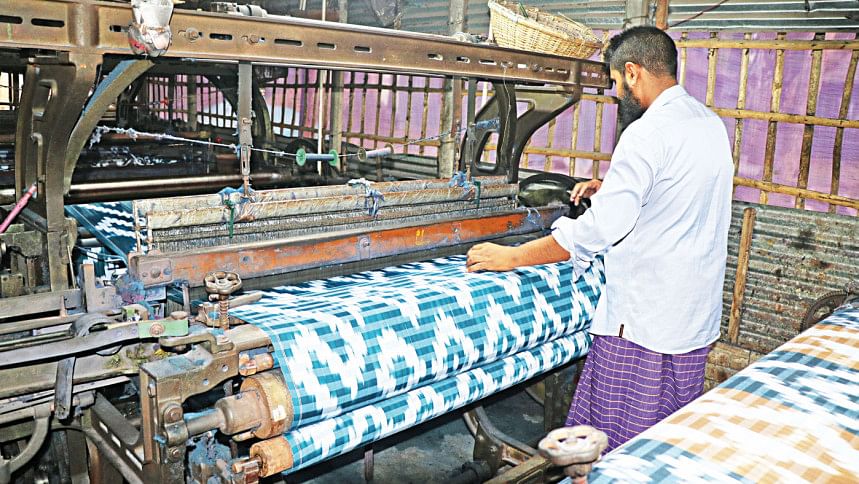Handloom clothing traders, weavers worried by poor demand

Sales of handloom clothing, such as saris and lungis, usually peak during the shopping season centring Eid-ul-Fitr, the biggest religious festival for Muslims in Bangladesh.
However, weavers and traders of handloom clothing in Pabna and Sirajganj, the two biggest producing regions, are been left disappointed by poor demand this year.
"I would sell clothes worth Tk 4-5 lakh daily after Shab-e-Barat as retailers from across the country would come to source their products as early as possible for the Eid market," said Md Monir Hossain, a trader of Pabna's Ataikula wholesale hub, which opens twice weekly on Thursday and Friday.
"I have sold just Tk 1.5 lakh worth of clothes so far as customer turnout was considerably low in the first two weeks of Ramadan," he added.
Md Arif Hossain, another wholesaler of the same market, said a good number of buyers purchased cheap clothes for distribution as Zakat during Eid last year. However, sales of such items are unsatisfactory this year.
Clothing prices have risen rapidly over the past year due to excessive production costs. For example, the price of an apparel item worth Tk 100 has increased by about 25 per cent this year.
The demand for handloom clothing, especially among low-income groups, has fallen this year due to price hikes
"So, the demand for handloom clothing, especially among low-income groups, has fallen this year due to the price hikes," he added.
Md Hyder Ali, a leading handloom clothing trader and manufacturer in Sirajganj, said the Shahzadpur Tant Kaporer Haat, one of the biggest hubs for handloom clothing, is seeing poor sales as well.
"It was normal to see sales of Tk 200 crore each week of the Eid market but now, sales have reduced by at least 25 to 30 per cent this year," Ali added.
He went on to say that this year's sales are even lower than that of the pandemic period.
"The price of cloth was cheaper during the pandemic while sales were good enough at the time," he said.

Regarding the higher raw material prices, Md. Shahin, a handloom clothing producer in the Dogasi Karigarpara area of Pabna sadar upazila, said each 45-kilogramme bundle of 80-count thread is now being sold for Tk 30,000 while it was Tk 20,000 a couple of years ago.
"At the same time, the price of colour and chemicals has nearly doubled," he told The Daily Star.
But despite the poor Eid sales, handloom clothing weavers were found busy at work all throughout Pabna and Sirajganj.
"We are getting small profit by investing our money and labour. Still, we are holding onto our inherited business in hopes of more profit," Shahin said, adding that he hired 20 looms near his factory targeting the Eid sales.
Last year, he supplied some 3,000 lungis ahead of Eid but this time, he has not been able to sell more than 2,000.
Md Hyder Ali, vice president of the Bangladesh Handloom and Power loom Owners Association, said there are around 6 lakh looms in Pabna and Sirajganj. However, more than 2 lakh of them have remained dormant for years not while the remaining 4 lakh are in full operation ahead of the festival.
"Despite poor Eid sales, weavers are busy for manufacturing clothes ahead of the festival targeting to get maximum business and profit," Hyder added.
Weavers usually begin production from the Shab-e-Barat night while most sales are traditionally complete by the first week of Ramadan.

 For all latest news, follow The Daily Star's Google News channel.
For all latest news, follow The Daily Star's Google News channel. 








Comments